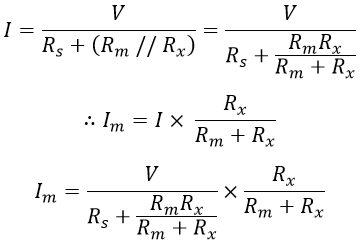An Ohmmeter is an electrical instrument by which we can measure the resistance of any electrical circuit component directly. It can also be used to check the continuity of the circuits. The accuracy of ohmmeters is moderate, it gives the approximate value of resistance, but can be used easily. Ohmmeters are of two types,
- Shunt type ohmmeter
- Series type ohmmeter
In this, let us see about the construction and working of shunt type ohmmeter and how resistance can be measured using an ohmmeter.
Shunt Type Ohmmeter :
The connection diagram for shunt type Ohmmeter is shown in the below figure. The meter consists of a D'Arsonval galvanometer (G) connected to a battery of known terminal voltage (V) through a switch (s) and a standard variable resistance (Rs). An unknown resistance (Rx) is connected across the terminals of the galvanometer (i.e., across 1 and 2).
If terminals 1 and 2 are connected across a high resistance or left open and the switch 's' is closed then the current through the meter (Im) will be the maximum current or full-scale deflection current (Ifsd). Hence infinite (∞) is marked at the full-scale deflection point which is on the right side of the scale. The below shows the scale of shunt type ohmmeter.
If terminals 1 and 2 are connected maximum current across a low resistance or short-circuited, then the maximum current flows through that resistor and meter current becomes negligible or even zero. Hence, the pointer will stay at its null position. So, the null position of the meter which is on the left side of the scale is marked as 0Ω.
If Rm is the internal resistance of the meter and terminals 1 and 2 are left open then the meter current is the full-scale deflection current.
When terminals 1 and 2 are connected across an unknown resistance Rx, circuit current is given as,
Therefore, the meter current expressed as a fraction of the full-scale deflection current is given by S = Im/Ifsd. Substituting Im and Ifsd in S, we get,
Thus, halfway mark on the scale. By substituting different values of Rx, the scale is calibrated directly in terms of ohms and the scale appears to be almost linear on the left and crowded on the right. As the Rm value is small so, Rm||Rx value is also small.
Hence, the shunt type ohmmeter gives better results for measurements of low resistances. It can be used in the laboratory as a testing instrument for low resistance applications. But due to its moderate accuracy, nowadays bridges are used which gives a high degree of accuracy.





